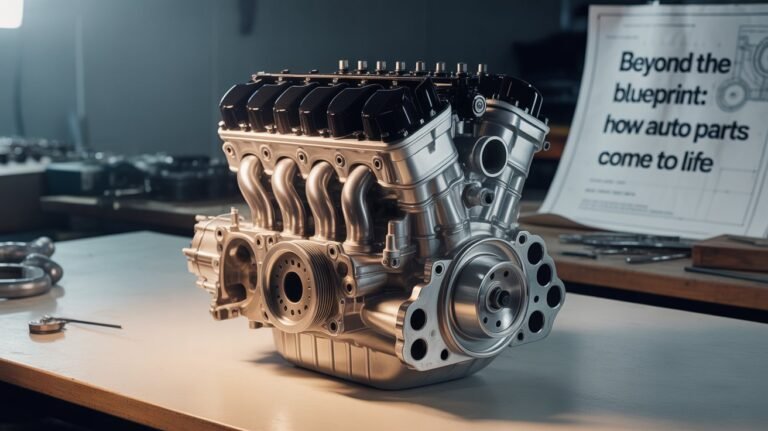When you open the hood of a car, you’ll see an intricate network of parts working together seamlessly. From the engine components to the braking system, each part plays a critical role in delivering performance, safety, and reliability. But how do these parts go from an idea on paper to the durable, high-performing components installed in your vehicle? The process of developing automotive parts goes far beyond the blueprint, blending creativity, engineering, testing, and precision manufacturing.
From Concept to Design
Every automotive part begins with a need. Automakers and suppliers identify challenges—improving fuel efficiency, enhancing safety, or reducing vehicle weight—and turn them into opportunities for innovation. Engineers then brainstorm potential solutions, often using computer-aided design (CAD) software to sketch detailed blueprints.
During this stage, factors like aerodynamics, heat resistance, strength, and cost-efficiency come into play. For example, a suspension component must be strong enough to withstand road impacts yet lightweight enough to improve fuel economy. Balancing these needs requires not only technical expertise but also creativity in design.
Material Selection Matters
Once the design is established, the next step is choosing the right materials. The material used for a part can determine its performance, longevity, and safety.
Metals like steel and aluminum are widely used for their durability and strength.
Plastics and composites are increasingly popular for lightweighting, especially in interior parts and body panels.
Advanced materials such as carbon fiber and high-strength alloys are used in performance vehicles where reducing weight without sacrificing strength is essential.
Material choice also considers environmental impact, as manufacturers are under increasing pressure to develop recyclable and sustainable parts.
Prototyping and 3D Modeling
Before mass production, prototypes bring ideas to life. Using 3D printing and rapid prototyping, engineers can build a physical model of a part directly from CAD data. This allows them to test fit, function, and design quickly and cost-effectively.
Prototyping is crucial for identifying potential issues early in the process. For instance, a component might look flawless on screen but interfere with neighboring parts when installed in the actual vehicle. Making these adjustments early saves both time and money.
Testing for Performance and Safety
No automotive part reaches production without rigorous testing. Safety and performance are top priorities, and manufacturers put prototypes through a variety of simulations and real-world trials.
Stress testing ensures the part can withstand high pressure, vibrations, or extreme temperatures.
Fatigue testing checks how long a component can last under repeated use.
Crash simulations and safety assessments guarantee that parts like airbags or crumple zones perform as intended during accidents.
Only after passing these stringent evaluations can a part move to the next phase.
From Prototype to Production
Mass production is the stage where innovative design transitions into precise, large-scale manufacturing. Using advanced machinery, robotics, and automated systems, manufacturers are able to produce thousands of uniform parts with exceptional accuracy. Depending on the component, factories employ methods such as CNC machining, metal stamping, traditional injection molding, or prototype plastic molding to test and refine designs before full-scale production.
Throughout this process, quality control is paramount. Random samples from each production run are thoroughly inspected to ensure they meet rigorous specifications. Even the smallest flaw in a critical component—like a brake pad or steering linkage—can pose serious safety risks, making consistency and precision absolutely essential.
The Role of Collaboration
Developing automotive parts is rarely the work of a single team. It’s a collaborative process involving designers, engineers, material scientists, manufacturers, and quality control experts. Additionally, suppliers often work hand-in-hand with automakers to meet specific requirements for each model.
Collaboration ensures that parts integrate smoothly into the broader vehicle system. For example, a new fuel injection system must work seamlessly with the engine’s design, electronics, and emission controls.
Innovation Driving the Future
The automotive industry is evolving rapidly, and so is the development of parts. Trends like electrification, autonomous driving, and sustainability are reshaping how parts are designed and manufactured.
Electric vehicles (EVs) demand new types of parts such as high-capacity batteries, lightweight frames, and efficient cooling systems.
Smart technology requires sensors, chips, and electronic control units to communicate within advanced driver-assistance systems (ADAS).
Green innovation is pushing the use of recycled materials, bio-based plastics, and parts designed for easy disassembly and recycling.
These innovations demonstrate that the future of automotive parts is not just about durability but also intelligence and environmental responsibility.
In Conclusion
Developing automotive parts is a fascinating journey that goes well beyond the initial blueprint. From concept and material selection to prototyping, testing, and production, each stage requires precision, creativity, and collaboration. The next time you admire the performance of a vehicle or appreciate its safety features, remember that countless hours of design and engineering went into making each part come to life.
As the industry embraces electrification and sustainability, the way auto parts are developed will continue to transform—ensuring that the cars of tomorrow are smarter, safer, and more efficient than ever before.
